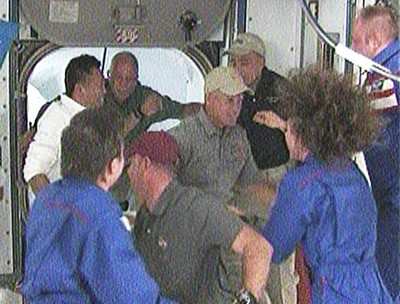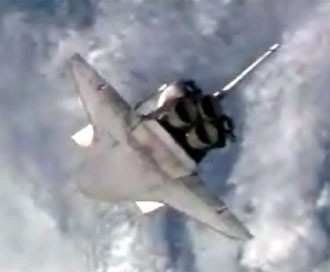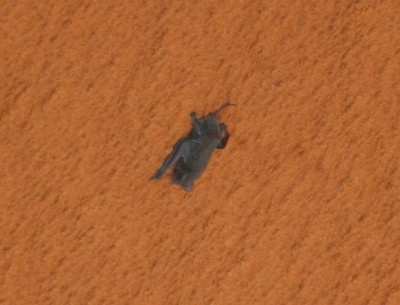Three Spacewalks Planned Over Next Eight Days
The space shuttle Discovery docked with the International Space
Station Tuesday afternoon, a little bit late but still on-schedule
for the start of a very busy 10-day stay at the orbital
complex.

Discovery docked to the Pressurized Mating Adaptor on the front
of the International Space Station's Harmony module at 5:19:53 pm
EDT. That's about six minutes later than NASA had estimated, but
wasn't cause for concern. Only a minor communications glitch
between the station and controllers in Houston marred an otherwise
flawless docking, which occurred over Lake Wells, western
Australia.
Between now and next Thursday, the combined STS-119 and
Expedition 18 crews will work to install the final set of solar
panels needed to generate enough power to support future six-person
crews.
Work that was originally slated to be completed in four
spacewalks will now be done in three, reports Agence-France Presse,
due to the loss of one day off the original two-week planned
mission time after Discovery's launch was delayed last week by a
hydrogen leak. The first 6.5-hour spacewalk is scheduled for
Thursday.

The shuttle and station crews opened hatches and greeted one
another at 6:09 pm, beginning more than a week of joint operations
between the two crews. One of the first major tasks of the crews
was to swap station crew member Sandra Magnus for Japanese
astronaut Koichi Wakata. The official swap occurred when a
specially fitted seat liner was installed in the Soyuz crew
vehicle. That swap at 9 pm signified the official designation
change making Wakata an Expedition 18 flight engineer and Magnus a
shuttle mission specialist.
Prime business for the crews Wednesday will be to lift the truss
segment out of Discovery’s payload bay with the shuttle robot
arm and hand it off to the station’s mechanical arm for an
overnight stay before Thursday’s permanent installation on
the station.
As Discovery approached the station prior to docking, STS-119
pilot Lee Archambault flipped the orbiter end-over-end to perform
the now-customary "backflip" maneuver, allowing ISS personnel to
record images of the shuttle's vulnerable heat shield. Those images
will be sent to mission control for review by engineers on the
ground, to confirm Discovery's underbelly didn't suffer from any
launch damage.

So far, the only glitch reported onboard Discovery is a broken
ergometer, used by the crew to exercise in zero-gravity.
Fortunately, astronauts were able to jury-rig some "rubber
bungee-type equipment" to make the machine usable.
In less NASA also disclosed a small bat seen clinging to
Discovery's external fuel tank Sunday during the countdown to
launch remained with the spacecraft as it cleared the tower. Based
on images and video, a wildlife expert who provides support to the
center said the small creature was a free tail bat that likely had
a broken left wing and some problem with its right shoulder or
wrist.
The animal (shown below) likely perished quickly during
Discovery's climb into orbit, NASA said.

Because the Merritt Island National Wildlife Refuge coexists
inside Kennedy Space Center, the launch pads have a number of
measures available, including warning sirens, to deter birds and
other creatures from getting too close. The launch team also uses
radar to watch for birds before a shuttle liftoff.
It was not the first bat to land on a shuttle during a
countdown. Previously, one of the winged creatures landed on the
tank during the countdown to launch shuttle Columbia on its STS-90
mission in 1998. That animal flew away as the engines ignited.
 ANN's Daily Aero-Term (05.17.24): Very High Frequency
ANN's Daily Aero-Term (05.17.24): Very High Frequency ANN's Daily Aero-Linx (05.17.24)
ANN's Daily Aero-Linx (05.17.24) ANN FAQ: Submit a News Story!
ANN FAQ: Submit a News Story! Classic Aero-TV: ANN Visits Wings Over The Rockies Exploration Of Flight
Classic Aero-TV: ANN Visits Wings Over The Rockies Exploration Of Flight Airborne Affordable Flyers 05.16.24: PRA Runway, Wag-Aero Sold, Young Eagles
Airborne Affordable Flyers 05.16.24: PRA Runway, Wag-Aero Sold, Young Eagles






